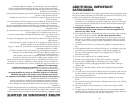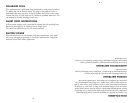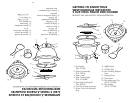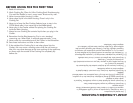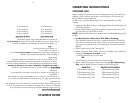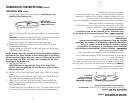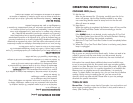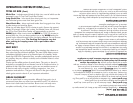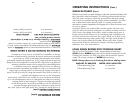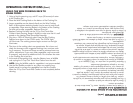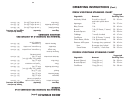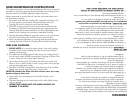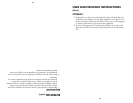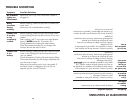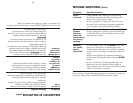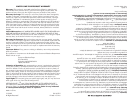
USER MAINTENANCE INSTRUCTIONS
This appliance contains no user serviceable parts. Do not try to repair it
yourself. Any servicing requiring disassembly other than cleaning must
be performed by a qualified appliance repair technician.
Always remember to unplug the unit from the wall outlet when not in
use and before cleaning.
1. Be careful not to dent the Cooking Pot, especially the bottom of it.
To work properly and produce the best cooking results, the
Cooking Pot must fit snugly on top of the thermostat.
2. DO NOT let loose grains of rice or other food particles fall into
the bottom of the Main Housing because they might prevent the
Heating Plate/Thermostat Assembly from fitting tightly against the
bottom of the Cooking Pot and cause inadequate cooking.
3. Use the plastic Rice Paddle or a wooden spoon to stir and remove
food from the Cooking Pot. NEVER use any metal utensils.
4. Never use abrasive cleansers or scouring pads because they can
damage the finish of both the Cooking Pot and Main Housing.
CARE AND CLEANING
1. PLEASE NOTE: It is normal to have a brown ‘rice crust’ coating
the bottom layer of the Cooking Pot when the rice has finished
cooking and steaming.
2. This appliance should be cleaned after every use. Unplug the unit
from the wall outlet. NEVER immerse Main Housing or Power Cord
in water. Allow the unit to cool before cleaning.
3. Let the Rice Cooker cool. Fill Cooking Pot with warm water and
allow to sit for a while. Wash in warm, soapy water with a sponge
and dry thoroughly with a cloth.
4. The Glass Lid, Wire Cooking Rack, Rice Measuring Cup and Rice
Paddle may also be washed in warm, soapy water.
CAUTION: Handle the Glass Lid with extreme care, as it may
become slippery when wet.
5. Never wash any removable parts of the Rice Cooker in the
dishwasher.
6. The Main Housing can be wiped clean with a soft, slightly damp
cloth or sponge.
7. NEVER POUR LIQUID INTO THE MAIN HOUSING OR
IMMERSE IT IN WATER.
14
14
ENTRETIEN
Cet appareil ne contient aucune pièce pouvant être réparée par
l’utilisateur. Ne pas tenter de le réparer soi-même. Toute réparation
nécessitant le démontage doit être confiée à un réparateur qualifié.
Toujours débrancher l’appareil de la prise murale lorsqu’il n’est pas
utilisé et avant le nettoyage.
1. Faire attention de ne pas abîmer le récipient de cuisson, en
particulier le fond. Pour bien fonctionner et donner les meilleurs
résultats possibles, le récipient doit être bien ajusté sur le
thermostat.
2. NE PAS laisser des grains de riz ou d’autres particules d’aliments
tomber au fond de la coque chauffante, car ils pourraient
empêcher le récipient de cuisson de bien reposer sur la plaque
chauffante/le thermostat et ainsi affecter la cuisson.
3. Utiliser la cuiller à riz en plastique ou une cuiller en bois pour
mélanger et retirer les aliments du récipient. NE JAMAIS utiliser
d’ustensiles en métal.
4. Ne jamais utiliser de nettoyants abrasifs ou de tampons à récurer,
ce qui endommagerait le fini du récipient et de la coque
chauffante.
NETTOYAGE
1. REMARQUE : Il est normal qu’une croûte de riz brun soit déposée
au fond du récipient une fois la cuisson terminée.
2. Nettoyer cet appareil après chaque usage. Le débrancher de la
prise murale. NE JAMAIS immerger la coque chauffante ou le
cordon d’alimentation dans l’eau. Laisser l’appareil refroidir avant
de le nettoyer.
3. Laisser le cuiseur à riz refroidir. Remplir le récipient de cuisson
d’eau tiède et laisser reposer quelque temps. Laver à l’eau tiède
savonneuse avec une éponge et bien essuyer avec un linge.
4. On peut aussi laver le couvercle en verre, la grille métallique, la
mesure et la cuiller à riz dans de l’eau tiède savonneuse.
MISE EN GARDE : Manipuler le couvercle en verre avec
précaution, car il peut devenir glissant lorsqu’il est mouillé.
5. Ne jamais laver les pièces amovibles du cuiseur à riz au
lave-vaisselle.
6. La coque chauffante peut être essuyée avec un linge doux ou une
éponge légèrement humide.
7. NE JAMAIS VERSER DE LIQUIDE DANS LA COQUE
CHAUFFANTE NI L’IMMERGER DANS L’EAU.



